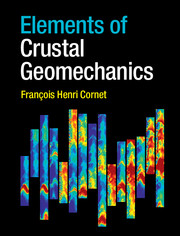Book contents
- Frontmatter
- Epigraph
- Contents
- Preface
- 1 Geomaterials and crustal geomechanics
- 2 Elements of rheology
- 3 Forces and stresses
- 4 Elements of kinematics
- 5 Elements of linear elasticity
- 6 From continuum mechanics to fluid mechanics
- 7 Elements of linear fracture mechanics
- 8 Laboratory investigations on geomaterials under compression 183
- 9 Homogenized geomaterials
- 10 Fractures and faults
- 11 Elements of seismology
- 12 Elements of solid–fluid interactions
- 13 Methods for stress field evaluation from in situ observations
- 14 Elements of stress fields and crustal rheology
- Appendix Elements of tensors in rectangular coordinates
- References
- Index
1 - Geomaterials and crustal geomechanics
Published online by Cambridge University Press: 05 April 2015
- Frontmatter
- Epigraph
- Contents
- Preface
- 1 Geomaterials and crustal geomechanics
- 2 Elements of rheology
- 3 Forces and stresses
- 4 Elements of kinematics
- 5 Elements of linear elasticity
- 6 From continuum mechanics to fluid mechanics
- 7 Elements of linear fracture mechanics
- 8 Laboratory investigations on geomaterials under compression 183
- 9 Homogenized geomaterials
- 10 Fractures and faults
- 11 Elements of seismology
- 12 Elements of solid–fluid interactions
- 13 Methods for stress field evaluation from in situ observations
- 14 Elements of stress fields and crustal rheology
- Appendix Elements of tensors in rectangular coordinates
- References
- Index
Summary
Geomechanics is concerned with the deformation and flow of geomaterials. A specific aspect of geomaterials, i.e. the materials that make up the planet earth, is their complex combination of solid and fluid phases.
In engineering geomechanics it is customary to talk of rock masses in a way that refers to both the rocks and the fracture systems that affect the volumes of concern. This concept, however, is often too vague for efficient mechanical modeling, and specific attention must be given to both the geomaterials and their discontinuities.
In the two first sections of this chapter we define more precisely the notion of a geomaterial and the related concept of a representative elementary volume (REV), with a brief reference to the various methods available for identifying geomaterials. In the third section we discuss the concepts of fracture sets and faults, with special attention to scaling laws. Finally, in the fourth section our attention turns to the various loading processes that may be encountered in geomechanics, whether of human or natural origin.
Rocks, soils and other geomaterials
Three kinds of rock can be identified: igneous, metamorphic and sedimentary. This characterization refers to the origin as well as to the past thermal and loading history of the rock. It implies strong consequences for the rock fabric, namely, the structure of its constitutive (solid) grains and of the complementary pore space, which is generally filled with fluid. And this introduces immediately the fact that materials of geological origin are most often multiphasic in their natural environment, i.e. they include solid, liquid and gas phases.
First, we introduce definitions that are used to describe the relative volumes occupied by the various phases. Then we introduce Goodman's classification of rocks according to their texture (Goodman, 1989), since in this book attention is given to the behavioral rather than to the genetic attributes of rocks.
- Type
- Chapter
- Information
- Elements of Crustal Geomechanics , pp. 1 - 30Publisher: Cambridge University PressPrint publication year: 2015



